24 Hours Hotline: +86 137-3541-1378
Email:beijing@tripstoshanghai.com
24 Hours Hotline: +86 137-3541-1378
Email:beijing@tripstoshanghai.com
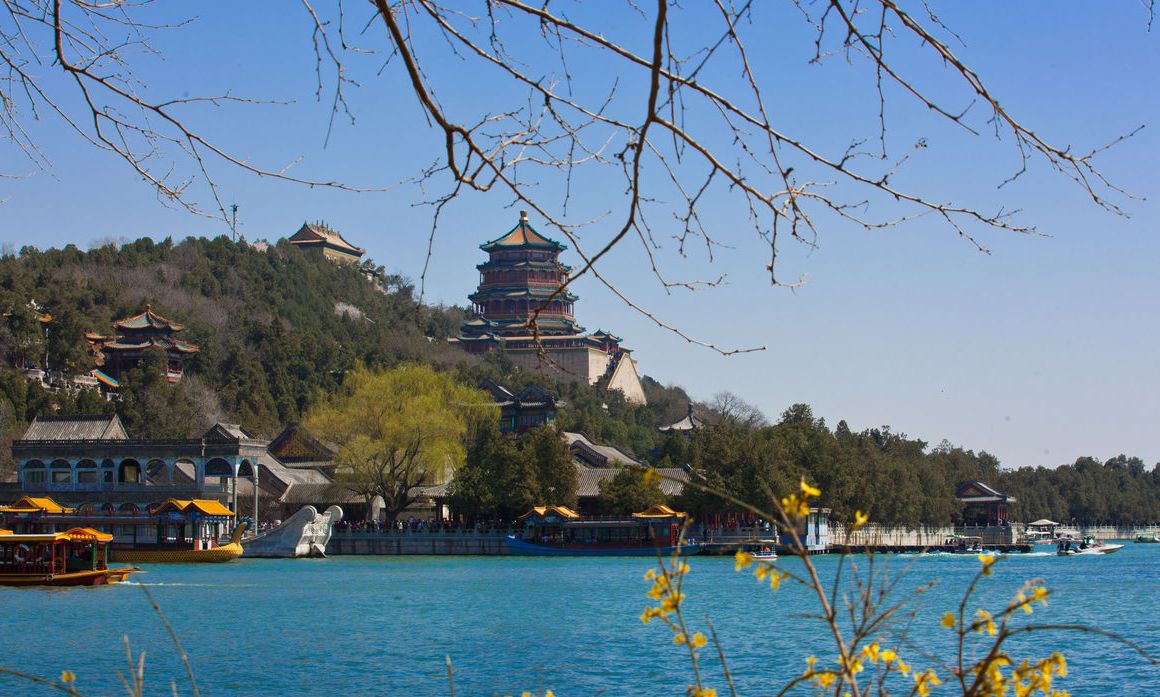
Introdution of Summer Palace
The
Summer Palace, is a vast ensemble of lakes, gardens and palaces in
Beijing, China. It serves as a popular tourist destination and
recreational park. Mainly dominated by Longevity Hill and Kunming Lake,
it covers an expanse of 2.9 square kilometres (1.1 sq mi),
three-quarters of which is water.
Longevity
Hill is about 60 metres (200 feet) high and has many buildings
positioned in sequence. The front hill is rich with splendid halls and
pavilions, while the back hill, in sharp contrast, is quiet with natural
beauty. The central Kunming Lake, covering 2.2 square kilometres (540
acres), was entirely man-made and the excavated soil was used to build
Longevity Hill.
In December 1998,
UNESCO included the Summer Palace on its World Heritage List. It
declared the Summer Palace "a masterpiece of Chinese landscape garden
design. The natural landscape of hills and open water is combined with
artificial features such as pavilions, halls, palaces, temples and
bridges to form a harmonious ensemble of outstanding aesthetic value".
History
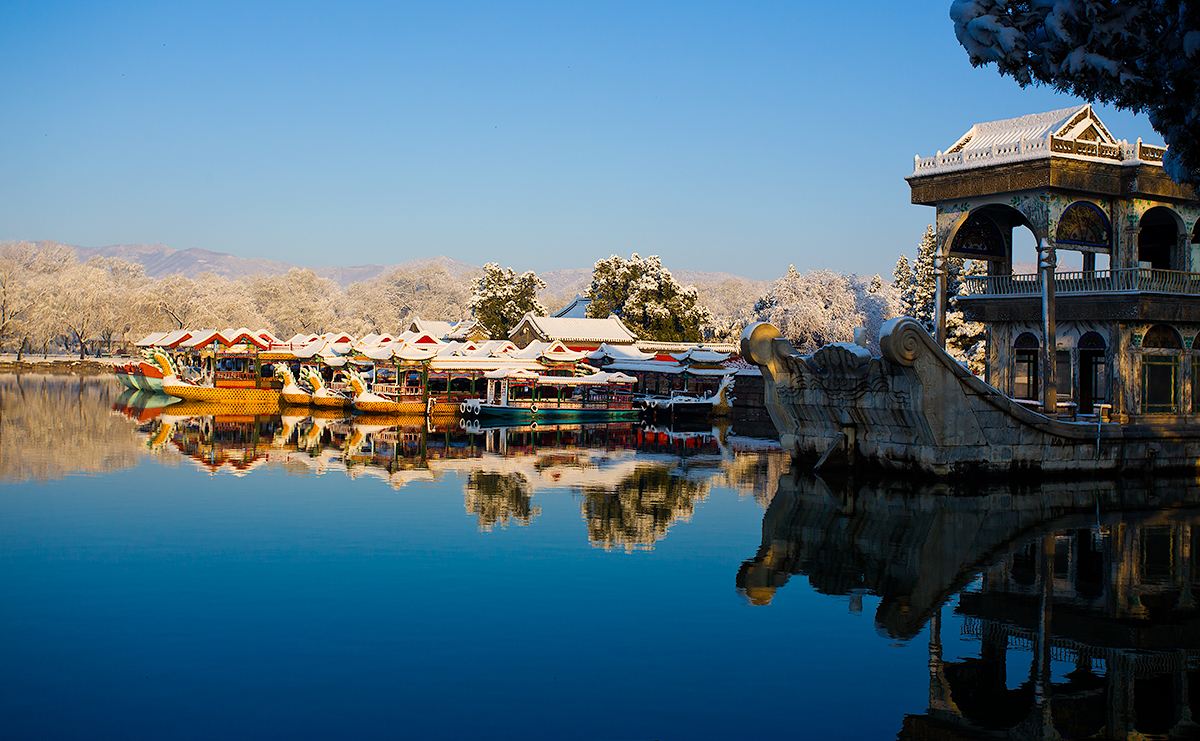
Pre-Qing dynasty
The
origins of the Summer Palace date back to the Jurchen-led Jin dynasty
in 1153, when the fourth ruler, Wanyan Liang (r. 1150–1161), moved the
Jin capital from Huining Prefecture (in present-day Acheng District,
Harbin, Heilongjiang) to Yanjing (present-day Beijing). He ordered the
construction of a palace in the Fragrant Hills and Jade Spring Hill in
the northwest of Beijing.
Around
1271, after the Yuan dynasty established its capital in Khanbaliq
(present-day Beijing), the engineer Guo Shoujing initiated a waterworks
project to direct the water from Shenshan Spring in Baifu Village,
Changping into the Western Lake (??), which would later become Kunming
Lake. Guo's aim was to create a water reservoir that would ensure a
stable water supply for the palace.
In
1494, the Hongzhi Emperor (r. 1487–1505) of the Ming dynasty had a
Yuanjing Temple built for his wet nurse, Lady Luo, in front of Jar Hill,
which was later renamed Longevity Hill. The temple fell into disrepair
over the years and was abandoned, and the area around the hill became
lush with vegetation. The Zhengde Emperor (r. 1505–21), who succeeded
the Hongzhi Emperor, built a palace on the banks of the Western Lake and
turned the area into an imperial garden. He renamed Jar Hill, "Golden
Hill" and named the lake "Golden Sea". Both the Zhengde Emperor and the
Wanli Emperor (r. 1572–1620) enjoyed taking boat rides on the lake.
During the reign of the Tianqi Emperor (r. 1620–27), the court eunuch
Wei Zhongxian took the imperial garden as his personal property.
Qing dynasty
In
the early Qing dynasty, Jar Hill served as the site for horse stables
in the imperial palace. Eunuchs who committed offences were sent there
to weed and cut grass.
In the
beginning of the reign of the Qianlong Emperor (r. 1735-1796), many
imperial gardens were built in the area around present-day Beijing's
Haidian District and accordingly, water consumption increased
tremendously. At the time, much of the water stored in the Western Lake
came from the freshwater spring on Jade Spring Hill, while a fraction
came from the Wanquan River (???). Any disruption of the water flow from
Jade Spring Hill would affect the capital's water transport and water
supply systems.
Around 1749, the
Qianlong Emperor decided to build a palace in the vicinity of Jar Hill
and the Western Lake to celebrate the 60th birthday of his mother,
Empress Dowager Chongqing. In the name of improving the capital's
waterworks system, he ordered the Western Lake to be expanded further
west to create two more lakes, Gaoshui Lake and Yangshui Lake. The three
lakes served not only as a reservoir for the imperial gardens, but also
a source of water for the surrounding agricultural areas. The Qianlong
Emperor collectively named the three lakes "Kunming Lake" after the
Kunming Pool (???) constructed by Emperor Wu (r. 141–187 BCE) in the Han
dynasty for the training of his navy. The earth excavated from the
expansion of Kunming Lake was used to enlarge Jar Hill, which was
renamed "Longevity Hill". The Summer Palace, whose construction was
completed in 1764 at a cost of over 4.8 million silver taels,was first
named "Qingyiyuan".
Post-Qing dynasty
In
1912, following the abdication of Puyi, the Last Emperor, the Summer
Palace became the private property of the former imperial family of the
Qing Empire. Two years later, the Summer Palace was opened to the public
and entry tickets were sold. In 1924, after Puyi was expelled from the
Forbidden City by the warlord Feng Yuxiang, the Beijing municipal
government took charge of administrating the Summer Palace and turned it
into a public park.
After 1949, the
Summer Palace briefly housed the Central Party School of the Communist
Party of China. Many of Mao Zedong's friends and key figures in the
Communist Party, such as Liu Yazi and Jiang Qing, also lived there.
Since 1953, many major restoration and renovation works have been done
on the Summer Palace, which is now open to the public as a tourist
attraction and park.
In November
1998, the Summer Palace was designated a World Heritage Site by UNESCO.
Towards the end of 2006, the Chinese government also started
distributing commemorative coins to celebrate the Summer Palace as a
cultural relic of the world.
Attractions
Front Hill
Eastern Palace Gate: The
main entrance to the Summer Palace. The two bronze lions on either side
of the gate are preserved from the Qianlong Emperor's time while the
Cloud Dragon Steps in front of the gate are relics from the Old Summer
Palace. The three Chinese characters "Yiheyuan" on the sign above the
gate were written by the Guangxu Emperor.
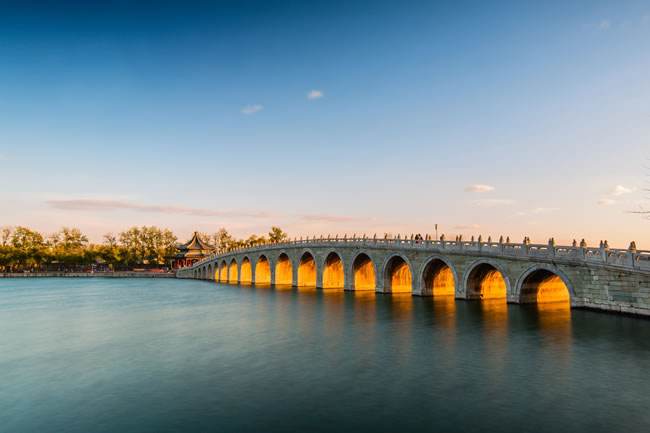
Hall of Benevolence and Longevity: The
hall where court sessions were held. It was called "Hall of Good
Governance" in the Qianlong Emperor's time but was given its present-day
name by the Guangxu Emperor. The well north of the hall is called
"Year-Prolonging Well" while the rockery behind the hall was designed to
imitate the Lion Grove Garden in Suzhou. The stalactites are relics
from the Old Summer Palace.
Hall of Jade Billows: Located
west of the Hall of Benevolence and Longevity. It was the living
quarters of the Qing emperors. The Guangxu Emperor was once confined
here by Empress Dowager Cixi.

Dehe Garden: Houses the three-storey Great Opera Hall, where opera performances were staged.
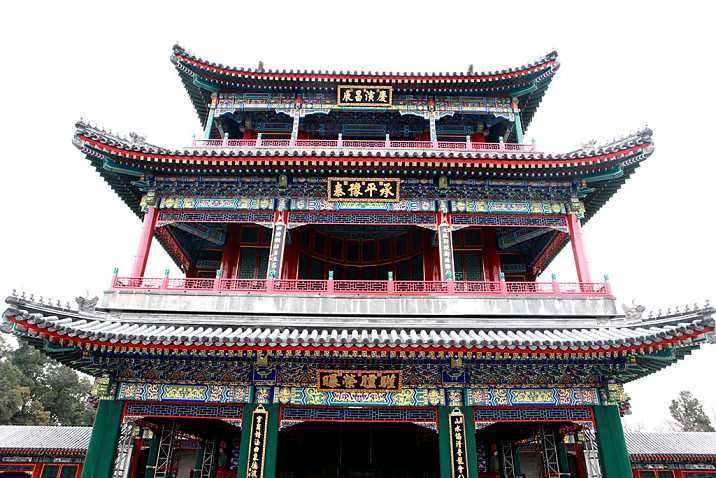
Long Corridor: Stretches from the Hall of Joy and Longevity in the east to Shizhang Pavilion in the west. The entire corridor is 728 metres long and contains artistic decorations, including paintings of famous places in China, and scenes from Chinese mythology and folktales, The Twenty-four Filial Exemplars and the Four Great Classical Novels.
Hall of Dispelling Clouds: Situated
on the centre of the central axis of Longevity Hill. Originally the
Great Temple of Gratitude and Longevity , it was renovated in 1892 and
became a place for Empress Dowager Cixi to receive guests, host grand
ceremonies, and celebrate her birthday.
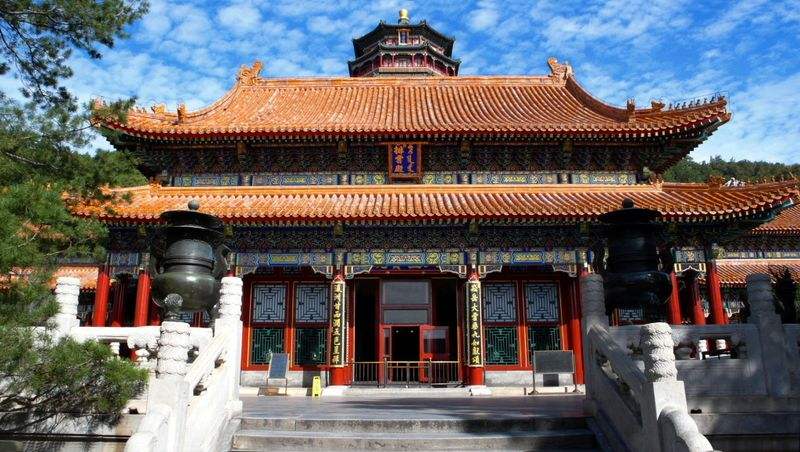
Back Hill
Suzhou Street: In
1762, after returning from touring the Jiangnan region, the Qianlong
Emperor ordered the construction of a shopping street resembling
Shantang Street in Suzhou. The street was destroyed by the British and
French in 1860 and was only restored in 1988.
Garden of Harmonious Pleasures: Located
in the northeast corner of the Summer Palace. In 1751, when the
Qianlong Emperor toured the Jiangnan region, he was so impressed with
Jichang Garden in Wuxi that he ordered a Huishan Garden to be built in
the Summer Palace and modelled after Jichang Garden. Huishan Garden was
renamed "Xiequ Garden" in 1811.
Four Great Regions: Located
on the centre of the central axis of the back hill. It was designed to
resemble the Samye Monastery in Tibet, and houses statues of
Bhaisajyaguru, the Buddha and Amitabha. It was destroyed by the British
and French in 1860 but was restored later.
Flower Pavilion and Glass Tower: Located
east of the back hill. It was destroyed by the British and French in
1860; only the Glass Tower remains. During the Cultural Revolution, the
Buddhist statue at the bottom of the tower was disfigured by the Red
Guards.
Prev: Terracotta Army
Next: Li River
Wechat: Chinaprivatetour
24 Hours Hotline:
+86 137-3541-1378
* Authentic Experiences: Genuine local experiences that immerse you in the true essence of Beijing and beyond.
* Safety First: Highest safety standards with secure activities and reliable transportation.
* Customizable Tours: Flexible itineraries tailored to your interests and needs.
* Local Expertise: In-depth knowledge of Beijing and China, offering exclusive insights.
* Professional Guides: Licensed bilingual guides with over 5 years of experience.
* Comfortable Travel: Experienced drivers and well-maintained vehicles for a smooth journey.
* Sustainable Tourism: Commitment to responsible tourism and supporting local communities.
* Customer-Focused: Personalized service and continuous improvement based on your feedback.
* Free Cancellation: Cancel up to 24 hours before travel for flexibility and peace of mind.
* 24/7 Support: Round-the-clock assistance for any questions or help needed.
1 to 1 tailor-made service from our professional travel advisors for the most sophisticated
Constantly excellent reviews for attraction, hotel and service Competitive price
Local experts provide quality tours Best selected knowledgeable local guides Authentic local restaurants
7*24 hours available to create you a worry-free tour. No Hidden Fees and absolutely no pressure to buy. Secured









Copyright © 2017 Chinabeijingprivatetour.com All rights reserved. 浙ICP备18056007号-2